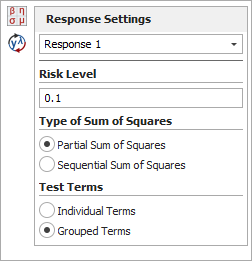Multiple Linear Regression Folio Control Panel
The multiple linear regression folio control panel allows you to control the settings for analyzing response data and displays the results of the analysis. This topic focuses on the Main page and Analysis page of the multiple linear regression folio control panel, which contains most of the tools you will need to perform the analysis. For more information about the control panel in general, see Control Panels.
Control Panel Main Page
- The Response drop-down list is used to select the response that all the displayed settings and analysis results will apply to.

- The Settings area is used to view/edit the settings for analyzing the selected response. An example is shown next. To configure the settings, click the blue text. These settings are also accessible on the Analysis Settings page of the control panel.

- The partial sum of squares ("Partial SS") and grouped terms are used.
- The specified risk level is 10%.
- No transformation is used (i.e., the "transformed" response, Y', is equal to the non-transformed response, Y). To configure this setting, you can click the text or the Select Transformation icon in the folio tools.
- "Analyzed" is shown in green, which indicates that the current response data has been analyzed using the current settings. Otherwise, this would show "Modified" in red.
- The last row indicates that the analyzed data consists of 12 observations.
In this example:
- The Analysis Summary area is shown when the current response data has been analyzed using the current settings. This area displays the terms that were found to be significant, as well as their associated regression coefficients. Click the View Analysis Summary icon in this area to view the details of the analysis results (including an ANOVA table).

Folio Tools
The folio tools are arranged on the left side of the control panel. Use these tools to configure your analysis and experiment with the analysis results. Depending on the type of design you are working with, the control panel may contain some or all of the following tools:
![]() Calculate analyzes the data for each response
that is selected to be included in the analysis. To exclude a
response from the analysis, clear the check box in its column
heading.
Calculate analyzes the data for each response
that is selected to be included in the analysis. To exclude a
response from the analysis, clear the check box in its column
heading.
![]() Plot creates a plot based on the analysis.
If you click this icon before the current data set has been analyzed,
an analysis will be performed automatically.
Plot creates a plot based on the analysis.
If you click this icon before the current data set has been analyzed,
an analysis will be performed automatically.
![]() Select Columns opens a window
that allows you to specify which columns will contain predictors
(i.e., factor level settings) and which will contain response
data.
Select Columns opens a window
that allows you to specify which columns will contain predictors
(i.e., factor level settings) and which will contain response
data.
![]() View Analysis Summary opens a
window
that contains detailed information about analysis results.
View Analysis Summary opens a
window
that contains detailed information about analysis results.
![]() Select Transformation opens a
window that allows
you to select a transformation to apply to each response.
Select Transformation opens a
window that allows
you to select a transformation to apply to each response.
![]() Prediction opens a window
that allows you to enter values for each factor and see predicted
results for the selected response.
Prediction opens a window
that allows you to enter values for each factor and see predicted
results for the selected response.
Control Panel Analysis Settings Page
The Analysis Settings page of the control panel includes additional settings and appears as shown next.

- The Response Settings drop-down list is used to choose the response that all the visible settings and analysis results will apply to. When you choose a response here, it will automatically be chosen when you return to the Main page.
- The Risk Level, or alpha value, is a measure of the risk that the analysis results are incorrect (i.e., alpha = 1 - confidence level).
- The next area allows you to specify the Type of Sum of Squares to use in the analysis. Select the Partial Sum of Squares option to test if a term is significant given that all other terms are considered in the model. Select the Sequential Sum of Squares option to test if an additional term is significant given that the terms before it are already in the model.
- The Test Terms area specifies what the information in the ANOVA table in the analysis results applies to. If you select Individual Terms, the software will separately examine the effects of each individual factor and/or factorial interaction. If you select Grouped Terms, it will examine groups of effect types, such as main effects, two-way interactions, etc.
You can also analyze the selected response or open the Select Transformation window by clicking the icons to the left of the Response Settings area.